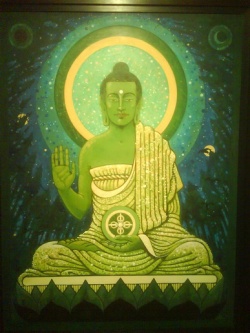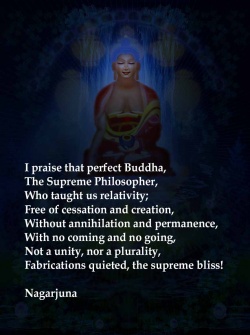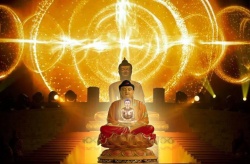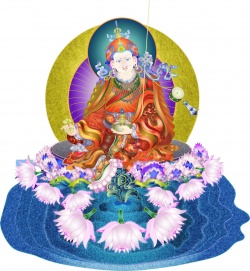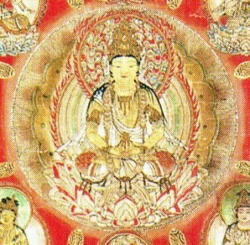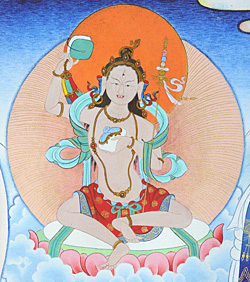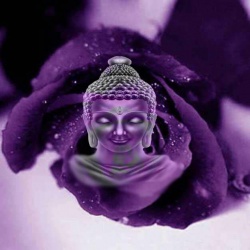Buddha nature
Click here to see other articles relating to word Buddha nature
- See also:Buddha-nature
The sun covered by clouds, a common metaphor for buddha nature temporarily veiled by the obscurations)
Buddha nature — when the Buddha became enlightened he realized that all beings without exception have the same nature and potential for enlightenment, and this is known as buddha nature.
Orgyen Tobgyal Rinpoche says:
- It is because this ground or sugatagarbha or potential is common to all beings that they are capable of attaining enlightenment. If they did not have such a ground then they could never become buddhas.
- For example: a stone doesn’t have the ‘ground’ or potential to produce oil, and so no matter how much you might press it and grind it—even if you use modern tools and machinery—you will never extract any oil.
A sesame seed, on the other hand, does have the potential to produce oil, and by pressing it in the right way, sesame oil can and will be produced.
So it is because the potential exists as part of our basic nature that we can become buddhas.
Sogyal Rinpoche writes:
- When we say Buddha, we naturally think of the Indian prince Gautama Siddhartha who reached enlightenment... Buddha, however, has a much deeper meaning.
It means a person, any person, who has completely awakened from ignorance and opened to his or her vast potential of wisdom[1].
A buddha is one who has brought a final end to suffering and frustration, and discovered a lasting and deathless happiness and peace.
- But for many of us in this skeptical age, this state may seem like a fantasy or a dream, or an achievement far beyond our reach.
It is important to remember always that Buddha was a human being, like you or me.
He never claimed divinity, he merely knew he had the buddha nature, the seed of enlightenment, and that everyone else did too.
- The buddha nature is simply the birthright of every sentient being, and I always say, “Our buddha nature is as good as any buddha’s buddha nature.”
This is the good news that the Buddha brought us from his enlightenment in Bodhgaya, and which many people find so inspiring. His message—that enlightenment is within the reach of all—holds out tremendous hope.
Through practice, we too can all become awakened. If this were not true, countless individuals down to the present day would not have become enlightened.[2]
How Do We Know That We Have Buddha Nature?
Ringu Tulku Rinpoche writes[3]:
- Although we are in samsara, we can still see proof of the existence of buddha nature permeating all living beings.
One way[4] in which we can discern whether beings have buddha nature is rik (Wyl. rigs; Skt. gotra) [see terms for buddha nature below], in other words the quality we perceive in one who possesses this buddha nature. [...]
All beings have buddha nature because all beings have within themselves what we call the essence of the buddha, this ju (Wyl. rgyu; Skt. hetu), this seed, which can blossom into a buddha and which constitutes our potential for enlightenment.
- But what is a buddha? Briefly, a buddha is one who has developed his or her compassion (Tib. tsé) and wisdom (Tib. khyen) to the ultimate level, beyond all limits.
Wisdom, in this context, refers not to an accumulation of knowledge but to the ability to see the true nature of things. what characterizes a buddha therefore is wisdom and compassion.
- To determine whether buddha nature exists in all beings, we nee to examine whether they possess the qualities of wisdom and compassion.
Without wisdom and compassion, it is impossible to become a buddha, but if one possesses even an embryonic amount of these qualities, one can them develop them to their ultimate level and become buddha.
The most concrete proof of the presence of this nature is that we possess, to varying degrees, these qualities of wisdom and compassion.
- According to Buddhism, there is no being, human or otherwise, who doesn't possess some wisdom and some compassion.
However bad, however evil, every being has a minimal amount of love, kindness, or compassion, at least for themselves or for one other being.
Maitreya says:
- རྫོགས་སངས་སྐུ་ནི་འཕྲོ་ཕྱིར་དང༌། །
དེ་བཞིན་ཉིད་དབྱེར་མེད་ཕྱིར་དང༌། །
རྟག་ཏུ་སངས་རྒྱས་སྙིང་པོ་ཅན། །
རིགས་ཡོད་ཕྱིར་ན་ལུས་ཅན་ཀུན། །
Because the perfect buddhas’s kaya is all-pervading,
Because reality is undifferentiated,
And because they possess the potential,
Beings always have the buddha nature.
- Maitreya, Sublime Continuum, I, 27
Terms for Buddha Nature
The usual term for ‘buddha nature’ in the Mahayana teachings is tathagatagarbha, but in the Vajrayana the term is sugatagarbha.
- Essence of the Bliss Gone (Skt. sugatagarbha; Tib. deshek nyingpo; Tib. བདེ་གཤེགས་སྙིང་པོ་, Wyl. bde gshegs snying po) or བདེ་བར་གཤེགས་པའི་སྙིང་པོ་, (dewar shekpé nyingpo)
- Essence of the Thus Gone (Skt. tathāgatagarbha; Tib. deshek nyingpo; Tib. དེ་གཤེགས་སྙིང་པོ་, Wyl. de gshegs snying po or དེ་བཞིན་གཤེགས་པའི་སྙིང་པོ་, deshyin shegpé nyingpo)
The Two Kinds of Potential (Skt. gotra)
In his Khenjuk, Mipham Rinpoche writes:
- The 'naturally present potential' (Skt. prakṛtistha-gotra; Wyl. rang bzhin gnas rigs) is the essence of the tathagatas.
In essence, it is naturally arising and uncompounded wisdom, the union of awareness and emptiness, the dharmadhatu which has always been inseparable from the kayas and wisdoms.
It is naturally pure, the nature of things, just as it is, pervading all phenomena, beyond any transition or change, like space.
Although it is within this context that the ordinary aggregates, elements and faculties of beings are born and die, this nature itself remains beyond birth and death.
It is through the realization of this nature that the Three Jewels come into being.
This immaculate 'element' (Wyl. khams) is present in all beings without exception as the very nature of their minds, just like the example of a treasure beneath the earth and so on.
Nevertheless, for those in whom this nature remains veiled by the four stains, and who have not activated their potential, despite its presence, it does not function in an apparent way [rather like a candle kept inside a jar].
And although they are naturally pure, because they are obscured by temporary veils, this nature is beyond most people's imagination.
If the veils that obscure the potential are reduced, it serves to inspire us with a longing to leave samsara behind and attain nirvana.
- The four veils that obscure our potential are
(1) an antipathy to the Mahayana teachings, (2) the view of self, (3) fear for the sufferings of samsara, and (4) a lack of concern for beings' welfare.
- The causes for purifying these veils are:
(1) an interest in the Mahayana teachings, (2) a high degree of wisdom, (3) meditative concentration (samadhi), and (4) love.
- When we possess these four, through the force of awakening our potential, we come to possess the 'developing potential' (Skt. samudānīta-gotra; Wyl. rgyas 'gyur gyi rigs) through which we can properly cultivate the virtues of the Mahayana.
Texts on Buddha Nature
Sutras
Treatises
Further Reading
- Douglas S. Duckworth, Mipam on Buddha-Nature:
The Ground of the Nyingma Tradition, State University of New York Press, 2008.
- Geshe Sonam Rinchen, Buddha Nature, Translated & Edited by Ruth Sonam, LTWA, 2003.
- S.K. Hookham, Buddha Within: Tathagatagarbha Doctrine According to the Shentong Interpretation of the Ratnagotravibhaga , State University of New York Press, 1992.
- Jamgön Kongtrül, The Light of Wisdom Volume 1, Ch. 8 'The Meaning of the Ground' & Appendix 4, 'The Sugata Essence' (Hong Kong: Rangjung Yeshe, 1995)
- Andy Karr, Contemplating Reality (Boston: Shambala Publications, 2007), pages 168-173.
- Ringu Tulku, Path to Buddhahood (Boston: Shambhala, 2003), '1. The Cause: Buddha Nature', pages 7-13.
- Tulku Urgyen Rinpoche, As It Is, Vol. I, Chapter 1 'The Basis: Buddha Nature', Rangjung Yeshe, 1999.
Footnotes
- ↑ See etymology in Buddha article.
- ↑ The Tibetan Book of Living and Dying, pages 48-49.
- ↑ Ringu Tulku, Path to Buddhahood (see references in 'Further Reading' section above).
- ↑ Ringu Tulku, in the same book, mentions two other ways to prove that all living beings have buddha nature—through scriptural authority and through describing precisely what buddha nature is and then dtermining if and how it manifests in beings.
Source
Buddha nature
仏性 (Skt buddha-dhatu or buddha-gotra; Jpn bussho )
The internal cause or potential for attaining Buddhahood.
The Sanskrit word dhatu means root, base, foundation, ground, or cause, and gotra means family, lineage, basis, source, cause, or seed.
Mahayana Buddhism generally holds that all people possess the innate Buddha nature, though its existence is obscured by illusions and evil karma.
The Nirvana Sutra is especially famous for the phrase
"All living beings alike possess the Buddha nature."
The history of Buddhism has witnessed doctrinal arguments concerning the Buddha nature, especially with regard to whether all people possess it.
The Dharma Characteristics (Chin Fa-hsiang; Jpn Hosso) school,
for instance, teaches the doctrine of the five natures, which classifies all people into five groups by their inborn capacities: those destined to be bodhisattvas,
those destined as cause-awakened ones, those destined as voice-hearers, an indeterminate group, and those who can neither become bodhisattvas nor attain the enlightenment of voice-hearers or cause-awakened ones.
Of these, only those destined to be bodhisattvas and some among the indeterminate group can attain Buddhahood.
In contrast, the T'ient'ai (Chin; Jpn Tendai) school, which is based on the Lotus Sutra, holds that all people are endowed with the three inherent potentials of the Buddha nature —the innate Buddha nature, the wisdom to perceive it, and the deeds to develop it —and therefore can attain enlightenment.
Source
Buddha nature; Buddha gotra (Skt); sang rgyas kyi khams/ rigs (Tib).
This is the potential for achieving Buddha-hood which is present within all sentient beings.
It consists of the mind which is vast, pure and unsullied.
Beings are held back by their adventitious defilements and obscurations.
Once these are removed, the true mind, characterised by both clarity and emptiness, will emerge.
bde bar gshegs pa'i snying po - Sugatagarbha.
The most common Sanskrit term for what in the West is known as 'buddha nature.' [RY]
bde gshegs snying po sgrub pa bka' brgyad - bde gshegs 'dus pa / - Eight Sadhana Teachings of Sugatagarbha [sic] the Assemblage of Sugatas [RY]
bde gshegs snying po sgrub pa bka' brgyad - Eight Sadhana Teachings of Sugatagarbha [JV]
bde gshegs snying po - {bde bar gshegs pa'i snying po} sugatagarbha; "buddha nature" potential/ heart essence for attaining/ reaching the state of bliss [[sutra context] potential]]/ heart essence which constitutes attaining/ reaching the state of bliss Dzogchen context] [RB]
bde gshegs snying po - buddha-nature, sugata-essence, sugatagarbha, essence of enlightenment present in all sentient beings [RY]
bder gshegs snying po - sugatagarbha, sugata-essence, "buddha- nature," "enlightened essence" [RY]
rtsal sna tshogs su snang ba - Expression manifest in manifold ways. The third of the three aspects of sugatagarbha: essence, nature, expression [RY]
lam phyag rgya chen po - Path Mahamudra. The stages of approaching the recognition of the sugatagarbha and of applying that recognition in one's practice [RY]
gshis gdangs rtsal - Essence, nature, and expression. The three aspects of the sugatagarbha according to the Mahamudra system [RY]
Buddha Nature - (Sugatagarbha / bde gshegs snying po)
Description
- It is not an "entity" but ultimate nature of mind, free from veils of ignorance.
Every sentient being has the potential to actualize this buddha nature by revealing perfect knowingness through pristine cognition of this nature of mind.
This is in a way the "primordial goodness" of sentient beings.
The innate all-pervasive primordial purity.
- Buddha nature (bde gshegs snying po). Sugata garbha, the essence of the sugatas; the potential for enlightenment or enlightened nature that is inherently present in each sentient being.
For a detailed discussions, see Thrangu Rinpoche's 'Buddha Nature,' Rangjung Yeshe Publications.
Etymology
Add etymology of Sanskrit and/or Tibetan terms here...
Relevance
- The buddha nature principle is most directly linked with Buddha Shakyamuni's third turning of the wheel of Dharma, where he addressed this topic at length in such sutras as Tathagatagarbha Sutra, the Mahayana Mahaparinirvana Sutra, and the Lankavatara Sutra, amongst others. Despite their roots in the Sutra tradition of the Mahayana, these teachings are also closely linked with the view and practice of the various Vajrayana traditions, such as Mahamudra and Dzogchen.
